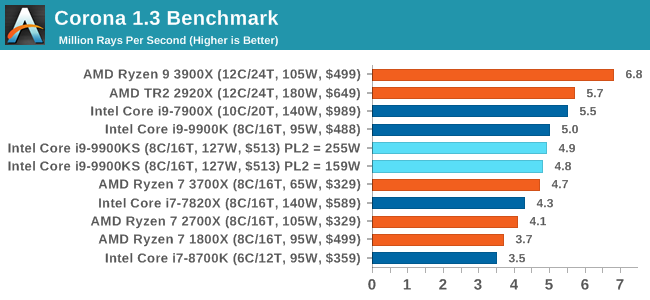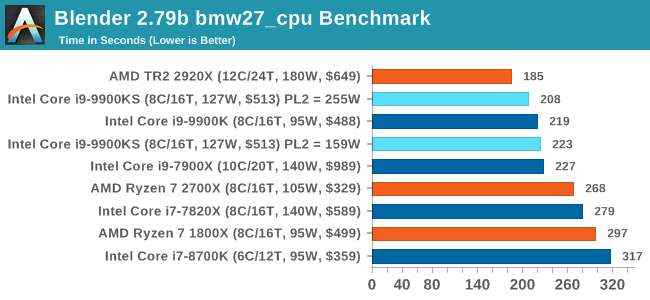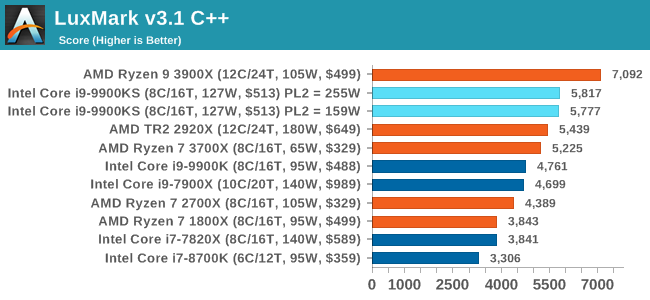The Intel Core i9-9900KS Review: The 5 GHz Consumer Special
by Dr. Ian Cutress on October 31, 2019 10:45 AM ESTCPU Performance: Rendering Tests
Rendering is often a key target for processor workloads, lending itself to a professional environment. It comes in different formats as well, from 3D rendering through rasterization, such as games, or by ray tracing, and invokes the ability of the software to manage meshes, textures, collisions, aliasing, physics (in animations), and discarding unnecessary work. Most renderers offer CPU code paths, while a few use GPUs and select environments use FPGAs or dedicated ASICs. For big studios however, CPUs are still the hardware of choice.
All of our benchmark results can also be found in our benchmark engine, Bench.
Corona 1.3: Performance Render
An advanced performance based renderer for software such as 3ds Max and Cinema 4D, the Corona benchmark renders a generated scene as a standard under its 1.3 software version. Normally the GUI implementation of the benchmark shows the scene being built, and allows the user to upload the result as a ‘time to complete’.
We got in contact with the developer who gave us a command line version of the benchmark that does a direct output of results. Rather than reporting time, we report the average number of rays per second across six runs, as the performance scaling of a result per unit time is typically visually easier to understand.
The Corona benchmark website can be found at https://corona-renderer.com/benchmark

Interestingly both 9900KS settings performed slightly worse than the 9900K here, which you wouldn't expect given the all-core turbo being higher. It would appear that there is something else the bottleneck in this test.
Blender 2.79b: 3D Creation Suite
A high profile rendering tool, Blender is open-source allowing for massive amounts of configurability, and is used by a number of high-profile animation studios worldwide. The organization recently released a Blender benchmark package, a couple of weeks after we had narrowed our Blender test for our new suite, however their test can take over an hour. For our results, we run one of the sub-tests in that suite through the command line - a standard ‘bmw27’ scene in CPU only mode, and measure the time to complete the render.
Blender can be downloaded at https://www.blender.org/download/

All the 9900 parts and settings perform roughly the same with one another, however the PL2 255W setting on the 9900KS does allow it to get a small ~5% advantage over the standard 9900K.
LuxMark v3.1: LuxRender via Different Code Paths
As stated at the top, there are many different ways to process rendering data: CPU, GPU, Accelerator, and others. On top of that, there are many frameworks and APIs in which to program, depending on how the software will be used. LuxMark, a benchmark developed using the LuxRender engine, offers several different scenes and APIs.
In our test, we run the simple ‘Ball’ scene on both the C++ and OpenCL code paths, but in CPU mode. This scene starts with a rough render and slowly improves the quality over two minutes, giving a final result in what is essentially an average ‘kilorays per second’.

Both 9900KS settings perform equally well here, and a sizeable jump over the standard 9900K.
POV-Ray 3.7.1: Ray Tracing
The Persistence of Vision ray tracing engine is another well-known benchmarking tool, which was in a state of relative hibernation until AMD released its Zen processors, to which suddenly both Intel and AMD were submitting code to the main branch of the open source project. For our test, we use the built-in benchmark for all-cores, called from the command line.
POV-Ray can be downloaded from http://www.povray.org/

One of the biggest differences between the two power settings is in POV-Ray, with a marked frequency difference. In fact, the 159W setting on the 9900KS puts it below our standard settings for the 9900K, which likely had an big default turbo budget on the board it was on at the time.











235 Comments
View All Comments
1_rick - Thursday, October 31, 2019 - link
As far as pricing goes, Microcenter lists it as in stock for $599 (might be an in-store only price). Newegg lists it for $569, but they're sold out.Sahrin - Thursday, October 31, 2019 - link
lol, this is supposed to be the chip Intel launches in response to AMD's second-best to get the 'last word' - instead it's a replay of Zen2 launch day all over again with the 9900K's sporty younger brother getting humiliated.ballsystemlord - Thursday, October 31, 2019 - link
Spelling and grammar errors:"...but the system was fully table the entire time."
"stable" not "table".
"...but the system was fully stable the entire time."
"It would appear that there is something else the bottleneck in this test."
Mis-written:
"It would appear that there is some other bottleneck in this test."
ballsystemlord - Thursday, October 31, 2019 - link
"One question that does remain however, is which set of results should we keep?" Keep to Intel guidelines. That's what you do with memory speeds and other things, I'm sure.That is also the guaranteed results for all consumers.
Goloith - Thursday, October 31, 2019 - link
Normally this hardware site is my "go to" for hardware reviews. However, holy mother of Jebus was this test bed terrible. Let's buy a Porshe and throw on old outdated tires on it. This should have been paired with a 2080 to, but you pair it with a 1080?Rule# 1, don't go full retard.
Goloith - Thursday, October 31, 2019 - link
Or with a 2080 tiDeath666Angel - Saturday, November 2, 2019 - link
The thing is, that would invalidate all older results. I'm guessing they will update the GPU in 2020 and retest certain legacy CPUs. What do you think would fundamentally change about the results with a newer GPU, though? I doubt it would be much, since the trends are the same with all the different graphical settings they already test at.ablevemona - Friday, November 1, 2019 - link
"in its hexagonal box"?Nichronos - Friday, November 1, 2019 - link
Why there isn't any Voltage table as all other Anandtech review have? We want to know how much can you undervolt the KS at the stock 5GHz!!!Thunder 57 - Friday, November 1, 2019 - link
Is that Katamari all over your new toys again??